8 Types Of Oats And How To Use Them
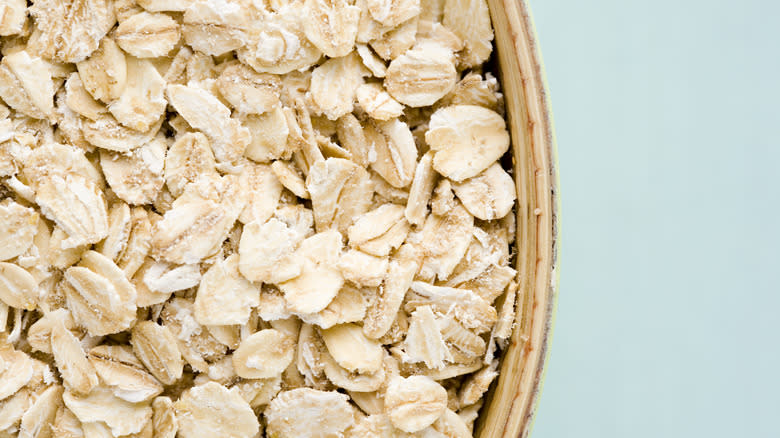
Oats have been a staple food for a long time, but it's only relatively recently that modern science has discovered all the wonderful things that happen to you when you eat oats daily. This ranges from weight loss to potentially even lowering your risk of heart disease. Given how many ways there are to prepare and enjoy oats, everyone should be able to find a way to incorporate them ... even if oatmeal isn't your favorite. If you're shopping for oats, you may have noticed a surprising variety available ... so, what gives? Are they all the same?
The answer is sort of, and not at all. All oats come from the same place, which is a type of grass scientifically known as Avena sativa. What makes them different is how they're prepared and processed, and this is where things get interesting. Different processes change oats in big ways, and knowing what those differences are is going to make preparing — and ultimately eating — oats much less painful than you might currently find it.
So, let's talk about all the different types, what you need to know about them, and the best way to prepare them so that you can improve your oatmeal game in a big way and become an expert on all things oats.
Read more: The Most Delicious Aldi Finds Of All Time
Oat Groats
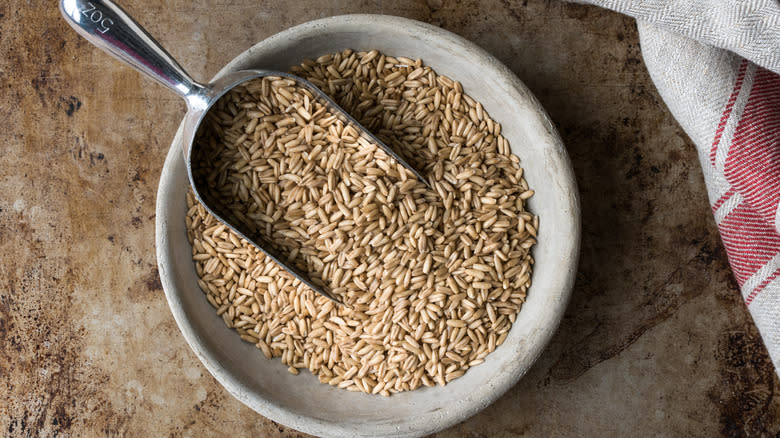
Oat groats are the least processed form of oats, and they're the closest edible form to what you'd get if you went out into a field of oats and picked some of the seeds. Groats have the husk removed, and that's it. While they might not have the name recognition that some of the other types of oats have, they're very widely available. This is great news as they're incredibly versatile, and if they're not already one of your pantry staples they definitely should be.
They can be used for oatmeal, of course, but there's no reason to stop there. Oat groats have a wonderfully nutty texture, and they're perfect in savory grain bowls and salads. They're also brilliant additions to hot dishes including soups, stews, risotto, and chili. There's almost no way to go wrong with these, and they can be added to baked goods like bread, cookies, cereal bars, and energy bites.
Depending on the recipe — and if you're planning on using them in their basic form — oat groats may require a bit of pre-cooking, but it's super easy: Just add water, a bit of salt, and cook for around 30 minutes. Picked up a bag and now you're not sure what to do with the rest of it? Grinding oat groats gives you oat flour that can be used in a wide variety of recipes.
Steel-Cut (Irish) Oats
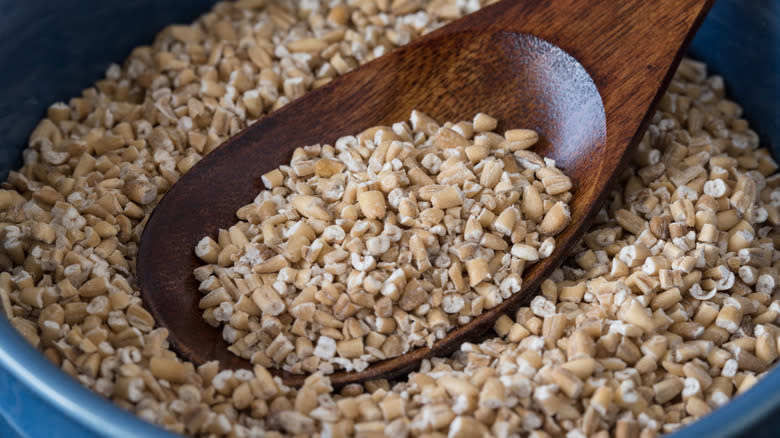
There are a few different names for steel-cut oats, including coarse (or coarse-cut) oats and Irish oats. They're all the same, and they're basically made by taking the oat groat and chopping it into a few pieces with a steel blade. Because they're so minimally processed, they tend to be chewier than other varieties. There's an interesting thing that happens with steel-cut oats, too. Even though they're nutritionally the same as other kinds of oats — they're all the same grain, after all — they're particularly good for weight management. Why? Minimal processing means they're prepared with more liquid, fill you up faster, and get processed through your system at a slower rate.
They've also been around for a long time, and it's no coincidence that they're also called Irish oats: They've been a staple of the Irish diet since somewhere around the year 438. Seriously, how cool is that?
The downside is that they do take a while to cook, and we all know that taking half an hour to cook oatmeal for breakfast on a busy morning just isn't always going to fly. There's good news, however: They're great for overnight oats. There's no reason to use them just for oatmeal, either, as they make great pancakes, cookies, biscuits, pies, scones, and muffins. They're also brilliant in savory recipes like oatmeal and potato pancakes, risotto, and even burgers.
Scottish Oats
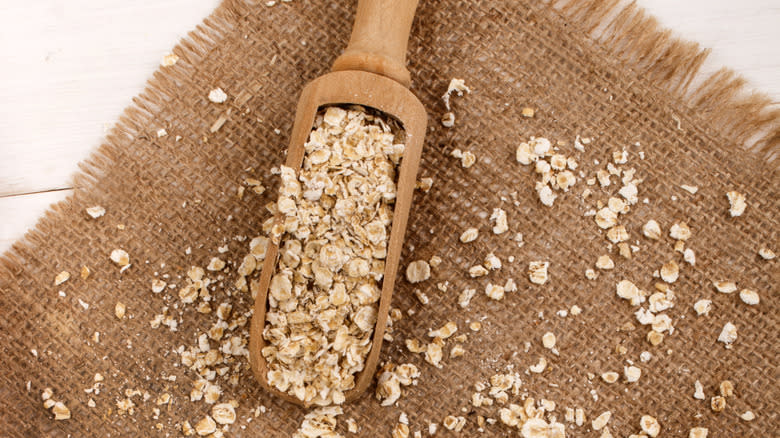
Are Scottish oats different from Irish oats? Yes! They start out very similar, as after they're harvested they're cleaned and then hulled, which essentially turns them into oat groats. From there, they're baked in a kiln, which not only dries them but helps release their flavor and extend their shelf life. Then comes the big difference: Steel-cut oats are cut with steel blades (as the same suggests), but other varieties are ground between grinding stones. How far apart the stones are determines how coarse they are.
When these oats are used in oatmeal, they generally make a creamier, less chewy oatmeal than steel-cut oats because of the finer grind. Scottish oats are good for much more than just oatmeal, though, and are great when added to savory dishes like shepherd's, cottage, or Caledonia pie, soups, roasts, meatballs, burgers, risotto, and pizza. On the off chance you're looking for a super authentic way to make haggis, they're also used in that. (Did you know that real, authentic haggis was banned from being imported into the U.S.?) In a little more mainstream sort of way, Scottish oats also make great pancakes, thanks to their creamy texture.
Rolled (Old Fashioned) Oats
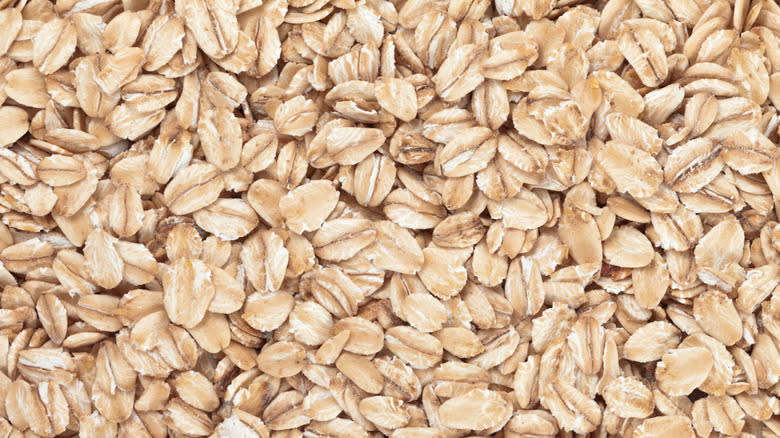
Old fashioned oats might be a more quaint-sounding name, but their other name — rolled oats — is a more accurate description of what they are. In a nutshell, rolled oats are made by taking oat groats, steaming them, and then flattening them between rollers. It's that rolling process that makes them softer than steel-cut oats, and while that might mean sacrificing a bit on texture and taste (as they're generally not as flavorful as less processed oats), there's a massive bonus to these, too — they cook much, much faster.
Rolled oats are really good for just about everything — particularly overnight oats. Why? They have the perfect balance of creaminess and chewiness. If you're having trouble perfecting overnight oats, make sure you're using rolled oats. Steel-cut oats are too chewy and can resist absorbing enough liquid to turn into delicious oatmeal, while quick oats — which are more heavily processed — can very easily turn to mush. Opt for rolled oats, and you might find there's no need to skip breakfast again.
Looking for some oatmeal ideas? Check out our round-up of recipe ideas that will keep you coming back for more oatmeal.
Quick Oats
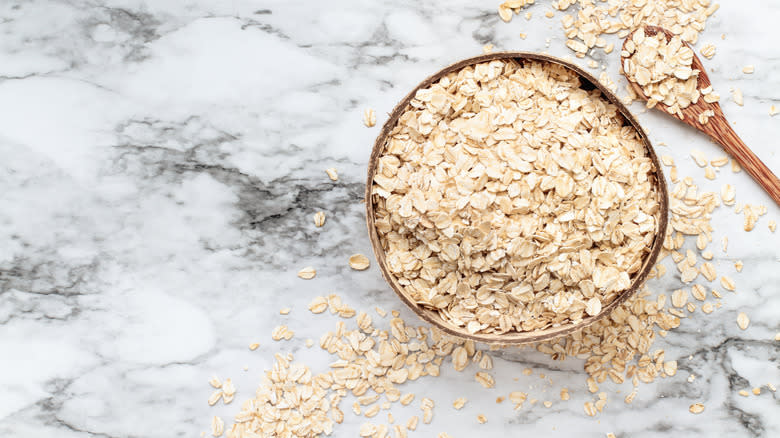
We're all busy, we get that. We're all looking for ways to make our daily routines a little more efficient, and the idea of quick oats might seem like a good one. They have all the nutrition of other kinds of oats but with a fraction of the time investment ... right? That might be true, but if you or anyone else in your family has had an unpleasant experience with the texture of oatmeal, there's a good chance that quick oats are to blame.
Quick oats are more heavily processed than other kinds of oats and they're basically rolled oats to the extreme. They're rolled thinner and steamed for longer during the processing period, which results in an oat that cooks faster. It's a trade-off, sacrificing flavor and texture for convenience. Quick oats cook so fast that they can be microwaved, which is great in a pinch, but probably isn't what you're looking for when you want to make some really good oatmeal.
Because they've already been pre-cooked, they're acceptable for overnight oats but perhaps aren't the best. Instead, use them in things like no-bake cookies, granola bars, or no-bake energy bites.
Instant Oats
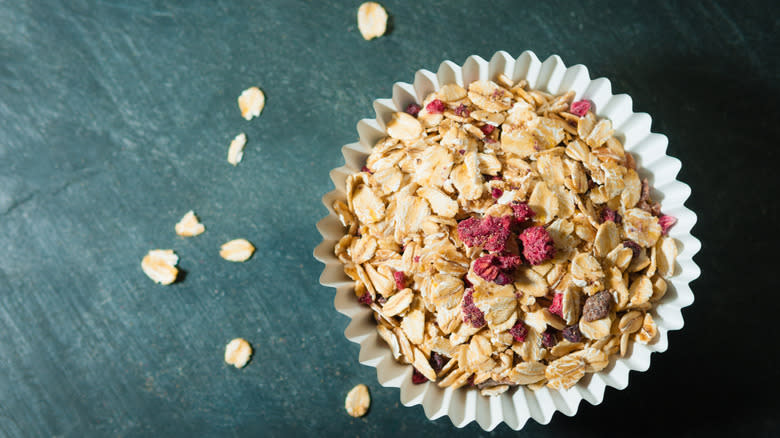
Simply put, instant oats are the ones in the little packets. They're quick, they're easy, you can combine them with some hot water and you have oatmeal that will fill the void until you can get something more substantial. They're fine, but put them side-by-side with oatmeal made from steel-cut oats and the difference will be very clear. But why is there such a difference? While steel-cut oats are only oat groats that have been chopped with a blade, instant oats have been processed, cooked, and then dried before being packaged.
That means their uses are actually pretty limited. Baking with them is going to add a weird texture to whatever you're using them in, and no one wants that. Factor in all the additives, sugar, and flavors that usually come with them, and that's just a big ol' nope. They're also not great for adding to savory dishes, so what are they good for?
Instant oats are good for their intended purpose, and that's a quick breakfast. And here's the thing — they're not even that great at that. Even though the oats themselves have beneficial elements to help you manage things like blood sugar and cholesterol, that can be offset by all those additives we mentioned. Unless you're opting for the unflavored kind, it's entirely possible you're getting most of the daily recommended limit of sugar along with your oatmeal. That's some serious food for thought.
Oat Flour
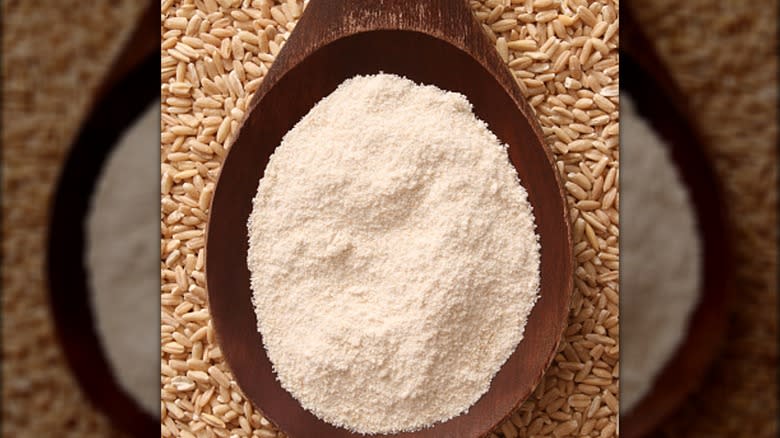
So, where does oat flour fall in the world of oats? Oat flour is basically oat groats that have been milled down into flour. Pretty straightforward, right? You definitely don't need a mill to make oat flour, either, and blitzing oats in a blender or food processor will give you a decent oat flour.
And that can be a pretty big deal. Oats come with a wide range of scientifically proven health benefits, and they are a valuable source of vitamins, minerals, fiber, and antioxidants. They help regulate weight, blood sugar, and cholesterol, all while helping to lower your risk of heart disease. It's an absolute win, but there are still only so many ways to liven up oatmeal so it doesn't get boring.
And that's where oat flour comes in. It's a great way to get a regular serving of oats but in a form that's not oatmeal. Make some banana bread, some cakes, some muffins, pancakes, cookies ... there's almost no limit to the number of baked goods that can be made with oat flour. It's the secret ingredient to some seriously delicious chocolate chip cookies that you'll want to make again and again. Never feel guilty about baking again!
Wait, So What Is Oat Bran?
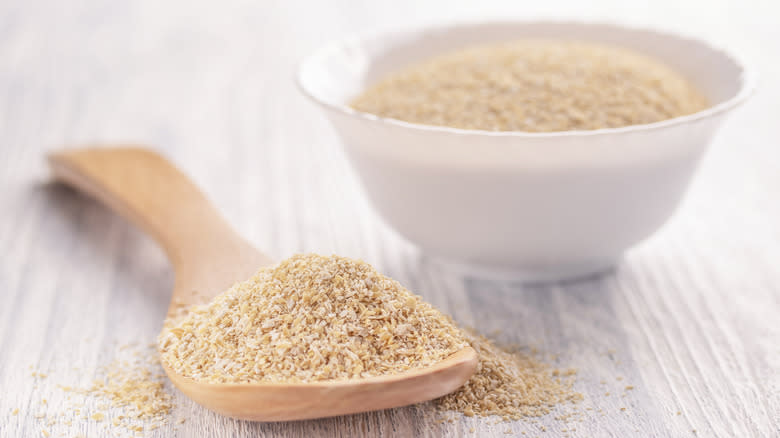
Oat bran has a bit of a reputation — it's the muffins that you get when you're running late to work and all the good ones have been taken. It's the cereal that you start buying when you hit a certain age, it's the bread that you eat out of necessity rather than actual want. But what, exactly, is it? Oat bran is actually a part of the oat groat: When hulls are removed from the oat seed, the layer immediately underneath the hull is oat bran.
It's earned that reputation as a healthy food, as it has many of the same benefits as oats. That includes being rich in vitamins and nutrients, fiber, and antioxidants, and helping to manage things like weight and blood sugar. Interestingly, it's also been linked to gut health, too, from keeping everything moving along with the regularly scheduled programming to even lowering the risk of colorectal cancer. Those oat bran muffins are looking better now, aren't they?
That's not the only use for it, and oat bran can be used to make bread that you're going to want to eat. Go figure! The key is finding a combination that works because when it's added to some whole wheat bread recipes, it's downright delicious. It also works well in smoothies and can add a lovely texture to your morning shake. Who says oats have to be boring?
Read the original article on Mashed

